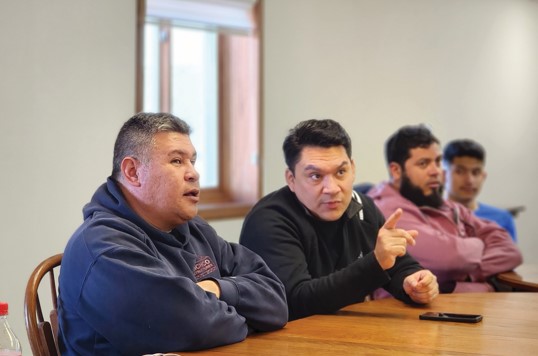Breaking Through Barriers Builds Loyalty
Richco Structures has learned a lot by teaching English
 If you read the quote ON THE RIGHT and either ignore it or guess its meaning, you prove its point. Across the country, more and more manufacturers are facing the challenge of navigating a language barrier within their workforce. The ability to communicate clearly and effectively is challenging enough when everyone speaks the same language, and it’s that much more difficult when they don’t.
If you read the quote ON THE RIGHT and either ignore it or guess its meaning, you prove its point. Across the country, more and more manufacturers are facing the challenge of navigating a language barrier within their workforce. The ability to communicate clearly and effectively is challenging enough when everyone speaks the same language, and it’s that much more difficult when they don’t.
Every day, despite political and practical barriers, more and more immigrants enter the United States looking for a better opportunity to live, work, and raise a family than they could find in their native country. This promise has drawn people to America for over three centuries, but many immigrants struggle to make their way here and put down roots.
Richco Structures in Haven, WI experienced this last year when it began to employ a group of immigrants from Nicaragua. “We hired them through a local temporary employment agency,” says Justin Richardson, the company’s president. “Through an interpreter, we learned the federal government had moved them around a couple of times and had put them up in a house in our community.”
Richco quickly incorporated the group into its workforce and was pleasantly surprised when an additional set of immigrants applied for work. “Three more showed up, and while they were really hard workers, we found we had quickly developed a pretty significant language barrier within our teams,” says Justin.

Unlike other learning environments, ESL learners in manufacturing facilities have proven to be motivated and very serious about mastering the material.
Overcoming the Barrier
Justin approached the company’s HR director, Kathy Kane, to look into the idea of teaching English to the new employees during the workday and it was met with immediate support. “Looking at the big picture, it was clear the investment in helping our new employees from Nicaragua learn English would bring many benefits to everyone involved,” says Justin.
Kathy took the lead and was able to find a local instructor through the Workplace Literacy Program offered by the Sheboygan Literacy Council. Gail Wilke, a retired teacher who coordinates the program, was one of Richco’s first instructors. “Our program was started four years ago through a private grant that asked us to teach English specifically in manufacturing,” says Gail. “Initially, we were working with two companies, but it’s grown quickly to the point we will soon be working with 13 companies.”
Gail says the foundational curriculum is based on standard education for English as a second language (ESL) learners. However, Gail and her team meet with employers ahead of time to learn more about their companies, individual job responsibilities, and common challenges that arise because of the language barrier. “In the case of Richco Structures, we incorporated a lot of terms related to trusses, the production equipment, and the materials,” says Gail. “We also focused on how to ask clarifying questions when they didn’t understand something related to their job responsibilities.”

Eagerness to Improve
One early victory Gail recalls was teaching the group the right commands in English when using walkie-talkies throughout the facility. “Communicating effectively through the walkie-talkies is a big deal because you don’t have that in-person feedback loop of facial expressions, body language, and hand gestures,” says Gail. “What I’ve discovered is they are eager to learn the language and thrive at their jobs.”
Gail also points out that unlike other learning environments, the ESL learners in these manufacturing facilities are very serious about mastering the material. “Not only do they focus and engage when we are together, but they work really hard outside of the classes to master the material and move on to the next lesson,” says Gail. “I think what many people don’t realize is how incredibly difficult English is to learn, but they persevere.”
 Justin agrees that they have seen rapid growth in the English spoken and understood by the workers that have gone through the program. “In fact, it’s been so successful we decided to offer Spanish language classes to the rest of our employees who have a vested interest in learning the language,” says Justin.
Justin agrees that they have seen rapid growth in the English spoken and understood by the workers that have gone through the program. “In fact, it’s been so successful we decided to offer Spanish language classes to the rest of our employees who have a vested interest in learning the language,” says Justin.
Developing Loyalty
After eight months of teaching English to the Nicaraguans at Richco Structures, Gail says only one person has left the company. “When you look at manufacturing today, that’s amazing retention,” she explains. “It’s even more significant when you consider these are good jobs that employers have a hard time filling.” Immigrants like the Nicaraguans at Richco Structures are helping the company grow in ways it couldn’t otherwise, creating more employment opportunities for everyone.
“This investment is clearly paying off,” Justin adds. “Not only are these classes very effective at reducing the language barrier throughout our company, but they are also transforming the lives of these people. We aren’t just giving them a job, we are helping them acclimate to the community and build better lives for themselves.”

Invertir en el éxito de una persona es un camino seguro hacia su corazón.
Gail points out that Richco’s approach in investing in these individuals is not lost on them and won’t be forgotten.
Bottom Line
The immigrant population in the U.S. will continue to grow, and with it will come more challenges related to language barriers in the workplace. Many component manufacturers (CMs) like Richco Structures are facing this problem today, leading to inefficiencies and frustrations. Richco took the initiative to pay its workers while they learned English on the job, with phenomenal results. If your company is intrigued by this concept, reach out to your local schools and workforce development boards to find out what resources and instructors they might be able to provide.
